
8
•
NITRO 4-TEC 3.3
TRAXXAS TQ 2.4GHz RADIO SYSTEM
INTRODUCTION
Your model includes the latest Traxxas TQ 2.4GHz transmitter with
Traxxas Link
™
technology. The transmitter’s easy-to-use design
provides instant driving fun for new R/C enthusiasts, and also offers
a full compliment of pro-level tuning features for advanced users
– or anyone interested in experimenting with the performance of
their model. The steering and throttle channels feature adjustable
Exponential, End Points, and Sub-Trims. Steering and braking Dual
Rate are also available. Many of the next-level features are controlled
by the Multi-Function knob, which can be programmed to control
a variety functions. The detailed instructions (page 36) and Menu
Tree (page 38) included in this manual will help you understand and
operate the advanced functions of the new TQ 2.4GHz radio system.
For additional information and how-to videos, visit Traxxas.com.
RADIO SYSTEM TERMINOLOGY
Please take a moment to familiarize yourself with these radio and
power system terms. They will be used throughout this manual.
A detailed explanation of the advanced terminology and features of
your new radio system begins on page 36.
2.4GHz Spread Spectrum – This model is equipped with the latest
R/C technology. Unlike AM and FM systems that require frequency
crystals and are prone to frequency conflicts, the TQ 2.4GHz system
automatically selects and locks onto an open frequency, and offers
superior resistance to interference and “glitching.”
Current - Current is a measure of power ow through the
electronics, usually measured in amps. If you think of a wire as a
garden hose, current is a measure of how much water is owing
through the hose.
Frequency band - The radio frequency used by the transmitter to
send signals to your model. This model operates on the 2.4GHz
direct-sequence spread spectrum.
mAh – Abbreviation for milliamp hour. A measure of the capacity of
the battery pack. The higher the number, the longer the battery
will last between recharges.
Neutral position - The standing position that the servos seek when
the transmitter controls are at the neutral setting.
NiCad - Abbreviation for nickel-cadmium. The original rechargeable
hobby pack, NiCad batteries have very high
current handling, high
capacity, and can last up to 1000 charging cycles. Good charging
procedures are required to reduce the possibility of developing a
“memory” effect and shortened run times.
NiMH - Abbreviation for nickel-metal hydride. Rechargeable NiMH
batteries offer high current handling, and much greater resistance
to the “memory” effect. NiMH batteries generally allow higher
capacity than NiCad batteries. They can last up to 500 charge
cycles. A peak charger designed for NiMH batteries is required for
optimal performance.
Receiver - The radio unit inside your model that receives signals from
the transmitter and relays them to the servos.
Servo - Small motor unit in your model that operates the steering
mechanism.
Transmitter - The hand-held radio unit that sends throttle and
steering instructions to your model.
Trim - The ne-tuning adjustment of the neutral position of the
servos, made by adjusting the throttle and steering trim knobs on
the face of the transmitter. Note: The Multi Function knob must be
programmed to serve as a throttle trim adjustment.
2-channel radio system - The TQ radio system, consisting of the receiver,
the transmitter, and the servos. The system uses two channels: one to
operate the throttle and one to operate the steering.
TQ 2.4GHz RADIO SYSTEM PRECAUTIONS
For maximum range, always hold the transmitter
so the antenna is in a vertical position (pointing
straight up). The transmitter’s antenna can
be swiveled and angled to allow for a vertical
position if necessary.
Do not kink the receiver's antenna wire. Kinks in
the antenna wire will reduce range.
DO NOT CUT any part of the receiver's antenna
wire. Cutting the antenna will reduce range.
Extend the antenna wire in the model as far as possible
for maximum range.
Do not allow the antenna wire to extend outside the body
without the protection of an antenna tube, or the antenna wire
may get cut or damaged, reducing range. It is recommended
to keep the wire inside the antenna tube to prevent the chance
of damage. An extra antenna tube has been included with your
model in the event that the original tube becomes damaged.
To prevent loss of radio range
do not kink or cut the black wire,
do not bend or cut the metal tip,
and do not bend or cut the white
wire at the end of the metal tip.
Correct
NoNo No
Learn terms related to
the TRX 3.3 racing engine
beginning on page 16.





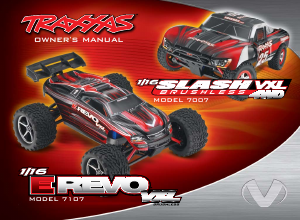

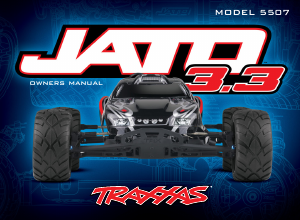
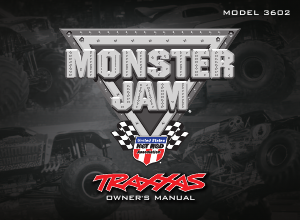
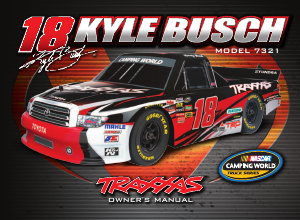
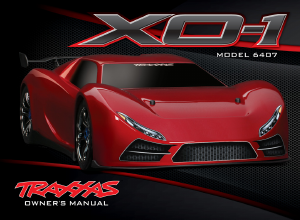
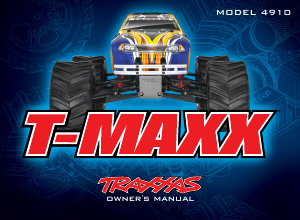
Join the conversation about this product
Here you can share what you think about the Traxxas Nitro 4-Tec 3.3 Radio Controlled Car. If you have a question, first carefully read the manual. Requesting a manual can be done by using our contact form.